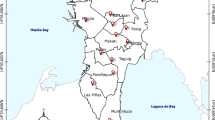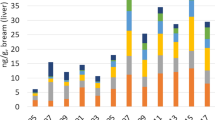Abstract.
Urinary naphthols, 1- and 2-naphthol, recently have been suggested as route-specific biomarkers for exposure to airborne polycyclic aromatic hydrocarbons. For the proper application of urinary naphthols as biomarkers, we studied effects of lifestyle on urinary naphthols levels in 119 Japanese male workers. After improving the detection limit of urinary naphthols up to 0.27 μg/L by high-resolution capillary gas chromatography/mass spectrometry/selected ion monitoring, urinary naphthols were detectable in approximately 90% of the subjects. Among detectable samples, the geometrical mean (GM) of urinary 1-naphthol concentration was 5.13 μg/L (geometrical standard deviation, GSD, 4.90), while the GM of urinary 2-naphthol concentration was 3.16 μg/L (GSD, 5.61). We observed that urinary 1- and 2-naphthol level were three- and sevenfold higher, respectively, among smokers than among nonsmokers (p < 0.01). The ratios of urinary 2-naphthol to 1-naphthol were significantly higher among smokers than nonsmokers (p < 0.05). The number of cigarettes smoked and urinary cotinine levels were also positively related to the concentration of urinary naphthols (p < 0.01), while other lifestyle factors, i.e., age and consumption of alcohol, greasy or salty food, sweets, fruits, vegetables, meat, or fish, were not. We also studied whether genetic polymorphisms of enzymes, which were involved in naphthalene metabolism, affected urinary naphthols levels. The cytochrome P450 (CYP) 1A1 exon 7 genetic polymorphism was not related to urinary naphthol levels. Among smokers, the subjects with c1/c2 or c2/c2 type of CYP2E1, which was determined by CYP2E1 RsaI polymorphism in 5′-flaking region, showed higher concentrations of urinary 2-naphthol than the subjects with c1/c1 type regardless of creatinine-correction (p < 0.05) and the subjects with glutathione S-transferase (GST) M1 deficient type showed higher concentrations of both urinary 1- and 2-naphthol than those with GSTM1 normal type but only without creatinine-correction (p < 0.05). Thus, when urinary naphthols are used as biomarkers, smoking and the genetic polymorphisms of CYP2E1 and GSTM1 should be considered.
Similar content being viewed by others
Author information
Authors and Affiliations
Additional information
Received: 6 January 1998/Accepted: 10 July 1998
Rights and permissions
About this article
Cite this article
Yang, M., Koga, M., Katoh, T. et al. A Study for the Proper Application of Urinary Naphthols, New Biomarkers for Airborne Polycyclic Aromatic Hydrocarbons. Arch. Environ. Contam. Toxicol. 36, 99–108 (1999). https://doi.org/10.1007/s002449900447
Issue Date:
DOI: https://doi.org/10.1007/s002449900447




